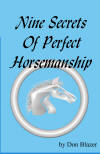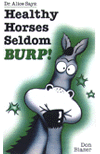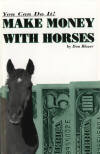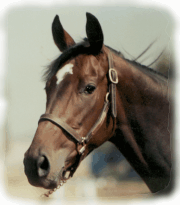
Don Blazer
Archives:
Stop Coggins Slaughter!
More on EIA
The Latest on EIA
Walter goes Hollywood
Stifles
Flying Horses?
Don't eat like a Pig
Parasites
Back Sore?
Goat Hero
Communication
Foals
History of Horses
Jumping Horses
Lameness and Health
Kick the IRS
Who's Walter?
Books by Don Blazer
View Our Catalog
Secure Book Order Form
Don Blazer
A Horse, Of Course
Secure Book Order Form
Order using our Secure Order Form

Walter (A Horse, of Course) Spills the Oats
Nine Secrets of Perfect Horsemanship
This is a Secure Web Site
Order using our Secure Order Form
View Our Catalog
This is a Secure Web Site
|
If there are a million ways to buy a bad horse, there must be at least
five ways to buy a good one.
To get a good horse, you have to use a little horse sense. Hard to do,
being human. Emotion usually gets the best of us.
Itís natural to be anxious and excited by the thrill of owning a new
horse. But whoa, hold it, shorten the reins!
I know the horse is beautiful, and the story that goes with him is
reasonable, and he may be sold tomorrow. But you asked, so accept this
fact: buyer beware!
Before you start looking for a horse, determine what it is you want.
Write down your requirements. Your list should include breed, age, size,
amount of training, color, sex, price and suitability for performing in
your area of interest. Only you know the answers, and you are the one who
must be satisfied.
Knowing what it is you want gives you a direction in which to search.
Bargain horses usually arenít bargains, so beware of sad stories, auctions
and the fast deal. Bad places to start your search.
Your horse may be anywhere, but there is a good chance he is with a
professional trainer who specializes in your area of interest.
A well-known trainer has a reputation to protect, and seldom, if ever, will
he let you get stuck with a bad horse, or a horse he thinks wonít fit your
needs.
Make appointments to see horses which fit your criteria, and then go see
them--all of them. The first horse you see may be the one you want, but
see the others so youíll know what you donít want.
Here is the first rule: follow your heart. You will know almost
instantly upon seeing a horse if it is one you should consider. If you
heart says, "yes, yes, yes," and the next four tests are passed, this is
your horse.
If there is the slightest doubt in your heart, after four more tests, this
is not the horse for you. Youíll find your horse, if you listen to your
heart.
Second test: study the person selling the horse, and take a good look at
the horseís surroundings. If the seller is neat, clean and takes some
pride in himself and his facility, then he probably cares for his horses in
much the same manner.
Ask to see the horse in his stall or pen. Wood chewers and cribbers leave
tell-tale signs. So do weavers and hole diggers. Bad habits are
physically hard on a horseís condition and health, and they are always hard
to break. You donít want those problems.
Ask to see the horse turned out so he can run free and you can see how he
moves and uses his body. The horse should be happy to see people, curious,
but not jumpy. He should have a clear, bright eye and should be smoothly
put together.
The horseís conformation should be pleasing to you. Conformation faults
or less than desirable traits for the performance which interests you can
be pointed out during a vet check. If you have conformation questions, be
sure to tell your veterinarian exactly what you intend to do with the
horse.
The third test is for performance ability and training.
Of course, if you are looking at a horse not yet trained to a saddle, then
you wonít be riding. But you certainly can watch the horse being longed,
tied, groomed and handled. Note carefully the horseís ground manners.
If the horse is performance trained, the seller may wish to ride the horse
first to show off the horseís talents. This is fine because it gives you
another chance to make some observations. If the seller is a bad rider,
chances are the horse has had a bad start and much reschooling is ahead.
If the seller jerks, bangs, spurs or hits the horse, pack up. You donít
want that bundle of trouble.
If you decide to ride, then the secret of the test is to see how
responsive the horse is to your cues, and how relaxed the horse is as he
performs. You want a partner with a good attitude and a willingness to
learn.
If the horse is already a champion, then you want a super pleasant attitude
to go with his performance record.
The fourth test is the vet check. You only want to know a few things.
How is the horseís breathing, his heart, and does he have obvious soundness
problems? (Look at the horseís shoes. Special shoes mean special
problems.)
If there are soundness problems, you want to know how to manage them.
Donít ask for and donít accept a pass-fail examination. You want
information to consider, not someone elseís choice of horses. You need to
make the final decision; it is your responsibility.
There is no way to predict the future or the soundness of a horse, so
donít try. Accept the uncertainty and enjoy what you have at the moment.
The final test is price. You set your price before you started looking,
so there should be no question now. If there is, what happened?
Donít overpay! If you feel you have overpaid for the horse, the horse is
going to suffer in any number of ways. Donít over extend yourself
financially.
On the other hand, if you can afford the price, buy the horse. A horse is
worth exactly what you believe heís worth, and are happy to pay.
Thereís no price limit on a perfect friendship.
Each month you'll find a new column on our web site. We hope you'll enjoy it, and maybe
e-mail us with questions or suggestions for other
columns. A Horse, Of Course is a weekly column syndicated
by Success Is Easy. If you like the column, call your local newspaper, or local horse
publication and ask them to subscribe by contacting Success Is Easy, 13610 N. Scottsdale Rd., Suite 10-406, Scottsdale, AZ 85254
________________________________
A Horse Of Course |
On-Line Catalog |
Who's Walter?
Courses and Clinics |
Horse Training |
Meet Don Blazer
Ask Don Blazer |
Horses for Sale |
News Flash
Stop Coggins Slaughter! |
Horse Links |
HOME
Info@donblazer.com
Copyright © 2000 by
Don Blazer
Success Is Easy, 13610 N. Scottsdale Rd., Suite 10-406, Scottsdale, AZ 85254
Vanndal Web Designs


